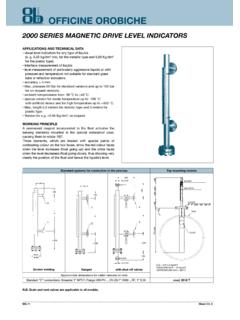Transcription of A4 layout new 4 - Sangir
1 1 Resistance ofPolypropyleneto ChemicalsTechnical InformationTesting: ISO normPolyethylenePolypropyleneEnglish2 About BasellBasell develops, produces andmarkets polypropylene, polyethylene,advanced polyolefin materials andpolyolefin catalysts, and alsodevelops and licenses in October 2000, Basell isowned equally by BASF and and its joint ventures servecustomers in more than 120countries with materials produced in18 countries. The company s networkof joint ventures expands Basell stechnology and market base andenables the company to follow keycustomers as they expand andglobalise their research and developmentcentres in Europe, North Americaand the Asia-Pacific region, Basellis continuing and expanding atechnological heritage that datesback to the start of the polyolefinsindustry.
2 The company is committedto continuously extending theproperty profile of its polyolefinsportfolio and to developing withits customers a shared agenda forbringing new products to marketas quickly as is committed to strong Health,Safety and Environmental (HSE)performance. The company sproducts are used in countlessconsumer and industrial goods fromfood and drink packaging to carcomponents, and from householdproducts to underground s corporate centre is located inHoofddorp, The Netherlands, nearAmsterdam. The company hasregional offices in Brussels, Belgium;Mainz, Germany; Wilmington,Delaware, USA; Sao Paulo, Brazil, andHong Kong, as well as sales offices inthe major markets around the resistance of polypropyleneproduced by Basell sold under thetrademarks moplen , Clyrell, Adstif andMetocene to chemicals is governed byits non-polar is resistant to manypolar liquids such as alcohols, organicacids, esters, and ketones.
3 However,it is swollen by aliphatic and aromatichydrocarbons and by halogenatedhydrocarbons. The less crystallinethe polymer, the greater the also causes a drop inmechanical strength. However, afterthe liquids that cause the swelling haveevaporated, polypropylene regains itsoriginal is resistant to aqueoussolutions of inorganic salts and toalmost all inorganic acids and alkalis even at high concentrations andtemperatures above 60 C. However,strong oxidizing agents ( chloro-sulfonic acid, fuming sulfuric acid,concentrated nitric acid and halogens)will attack polypropylene at roomtemperature. For medical applicationsrequiring sterilisation with steam,ethylene oxide or gamma ray, Basellhas developed special you are interested in such grades,please contact your local date, chemicals have never beenobserved to cause environmentalstress-cracking in is partially permeableto gases, low-boiling aliphatic andaromatic hydrocarbons, and halo-genated the following tables are the resultsof numerous tests according toISO 175.
4 The results are based on1 mm thick pressed samples stored for30 days, under no load conditions, inthe substance under investigation. Alsotaken into account where available, ispractical knowledge for longer termcontact with these substances. Theassessment of chemical resistance isbased on change in weight after 30days storage in the substance undertest as well as a tensile test on theswollen sample according to ISO suitability of contact to chemicalscan depend on the shape and require-ments of the many cases, it is imperative thatpractical tests are carried out to the tables abbreviations are used asfollows:Cold sat. = cold saturated solutionb=measured value at boiling pointof test substancea=aqueous solutionThe resistance tables are marked withfollowing symbols:+= ResistantAny swelling is slightwith only minor changes totensile yield stress.
5 =Limited resistanceNoticeable swelling and tensileyield stress is noticeably should be carried out toconfirm suitability in critical cases. = Not resistantSwelling is severe and tensileyield stress is severely symbol indicates that no testwas carried out under the ofPolypropyleneto Chemicals4 ChemicalsAcetic acida. 50+++Acetic acida. 10++++Acetic acid (glacial)100+ +Acetic anhydride100++Acetone100++ (b)+Acrylonitrile100++Allyl alcohola. 96+++Aluminium saltsa. all+++++Alums (all types)a. all++++Ammoniaa. 30+++Ammoniaa. 10++++Ammonia, gaseous100++Ammonia, liquid100+Ammonium acetatea. all+++++Ammonium carbonatea. all+++++Ammonium chloridea. all+++++Ammonium nitratea. all+++++Ammonium phosphatea. all+++++Ammonium sulphatea. all+++++Amyl acetate100 Amyl alcohol100+++Aniline100+++Anisole100 Barium saltsa.
6 All+++++Benzaldehyde100++Benzaldehydea. cold sat.++Benzene100 Benzoic acid100+++Benzoic acida. cold sat.+++++Benzyl alcohol100+ +Boraxa. cold sat.++++Boric acid100+++Boric acida. cold sat.++++Bromine vapourhigh Bromine vapourLow Bromine watercold sat. Bromine, liquid100 SubstanceConcentrationHomopolymerRandom Copolymerby mass (%)Heterophasic Copolymer20 C60 C100 C20 C60 C5 ChemicalsButane, gaseous100++Butane, liquid100+1,4-Butane diol100+++Butine diol100+++Butyl acetate100 n-Butyl alcohol (n-Butanol)100++Butyl glycol100++Calcium carbonatea. cold sat.+++++Calcium chloridea. cold sat.+++++Calcium hypochloritea. all+++Calcium nitratea. cold sat.++++Carbon disulphide100 Carbon tetrachloride100 Chlorine watercold sat. Chlorine, gas, dry100 Chlorine, gas, moist10 Chlorine, liquid100 Chloroacetic acid100+ Chlorobenzene100 Chloroform100 Chlorosulphonic acid100 Chromium salts (dibasic, tri basic)a.
7 Cold. sat.++++Chromium trioxide (Chromic acid)a. cold. sat. Chromium trioxidea. 20+ +Citric acida. cold sat.+++++Copper saltsa. cold sat.+++Cresols100+ +Cresolsa. cold sat.++Cyclohexane100 Cyclohexanol100+ +Cyclohexanone100+ Decahydronaphthaline100 Diethylether100 Diisopropylether100 Dimethytformamide100++1,4-Dioxan100 SubstanceConcentrationHomopolymerRandom Copolymerby mass (%)Heterophasic Copolymer20 C60 C100 C20 C60 C6 ChemicalsEthyl acetate100 Ethyl alcohol100++Ethyl alcohola. 96+++Ethyl alcohola. 50+++Ethyl alcohola. 10+++Ethyl chloride100 (b) (b)Ethylbenzene100 Ethylene chloride100 2-Ethylhexanol100++Formaldehydea. 40+++Formaldehydea. 30+++Formaldehydea. 10+++Formic acida. 98+ +Formic acida. 85+ +Formic acida. 50+ +Formic acida. 10+ +Fructosea. cold sat.
8 +++++Glucosea. cold sat.+++++Glycerine100++++Glycerinea. all++++Glycol100++++Glycola. all++++n-Heptane100 n-Hexane100 Hydrobromic acid50++Hydrochloric acid36+++Hydrochloric acid10++++Hydrofluoric acid40+++Hydrogen chloride, gasall+++Hydrogen peroxide30+ Hydrogen peroxide3+++Hydrogen sulphidea. low+++Iron salta. cold sat.+++++Isooctane100 SubstanceConcentrationHomopolymerRandom Copolymerby mass (%)Heterophasic Copolymer20 C60 C100 C20 C60 C7 ChemicalsIsopropylalcohol100+++Lactic acida. 90+++Lactic acida. 50+++Lactic acida. 10+++++Magnesium saltsa. cold sat.+++++Menthol100++Mercury100+++Mercur y saltsa. cold sat.++++Methyl acetate100++ (b) Methyl alcohola. 50+++Methyl alcohol (methanol)100++ (b)+Methyl ethyl ketone100+ Methylene chloride100 Morpholine100+++Naphthaline100+Nickel saltsa.
9 Cold sat.++++Nitric acid68 Nitric acid50 Nitric acid25+ Nitric acid10+++Nitrobenzene100+ +Oleic acid100++Oxalic acida. cold sat.+ +Ozone (< ppm)+ Phenol100+++Phenola. cold sat.+++Phosphoric acid85+++Phosphoric acid50+++Phosphoric acid10+++++Phosphorus oxychloride100+ Phosphorus pentoxide100++Phosphorus trichloride100+ Perchloroethylene (see tetrachloroethylene)SubstanceConcentrati onHomopolymerRandom Copolymerby mass (%)Heterophasic Copolymer20 C60 C100 C20 C60 C8 ChemicalsPhthalic acida. 50+++Potassium carbonate (potash)a. cold sat.++++Potassium chloratea. cold sat.+++Potassium chloridea. cold sat.+++++Potassium dichromatea. cold sat.++++Potassium hydroxide solution50++++Potassium hydroxide solution25++++Potassium hydroxide solution10++++Potassium iodidea. cold sat.
10 ++++Potassium nitratea. cold sat.++++Potassium permanganatea. cold sat.+++Potassium persulphatea. cold sat.++Potassium sulphatea. cold sat.++++Propane, gas100++Propane, liquid100+Propionic acida. 50+++Propylene glycol100+++Pyridine100 Silver salta. cold sat.++++Sodium acetatea. cold sat.+++++Sodium bisulphitea. cold sat.+++Sodium carbonatea. cold sat.++++Sodium carbonatea. 10+++++Sodium chloratea. 25+++Sodium chloride (common salt)a. cold sat.+++++Sodium chloritea. 5++Sodium hydrogen carbonatea. cold sat.+++++(sodium bicarbonate)Sodium hydroxide (caustic soda)100+++Sodium hydroxide solution50++++Sodium hydroxide solution25++++Sodium hydroxide solution10+++++Sodium hypochloritea. 13 Sodium nitratea. cold sat.++++Sodium nitritea. cold sat.++Sodium perboratea. cold sat.+++++Sodium phosphatea.








